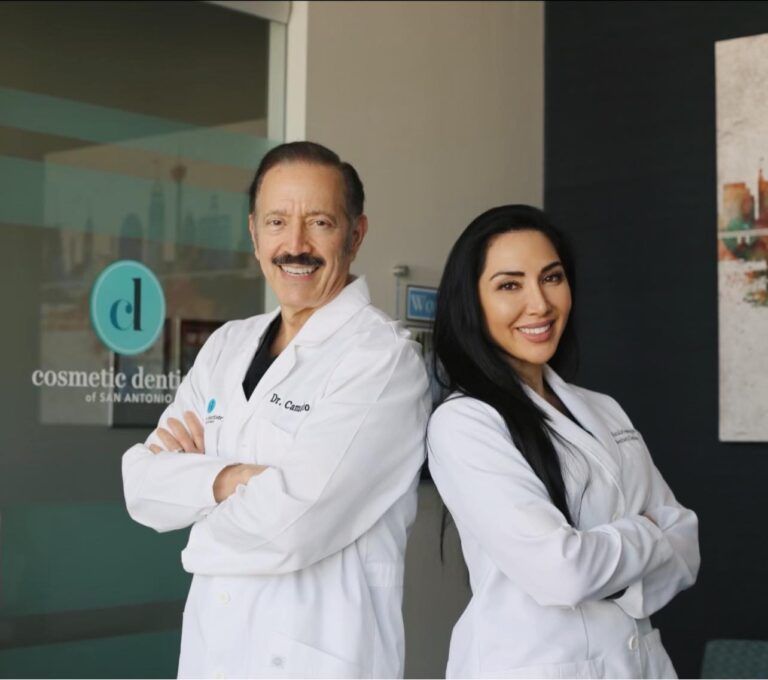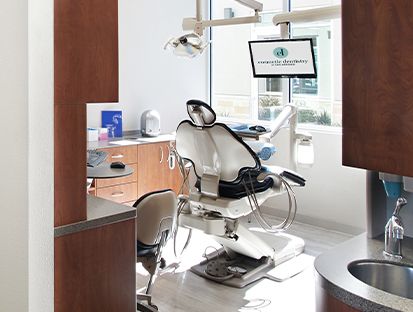A bright, radiant smile is often seen as a key component of confidence and beauty. As such, teeth whitening has become one of the most sought-after treatments in cosmetic dentistry. With advancements in technology and a growing array of options, the field of teeth whitening has evolved significantly. This blog delves into the latest trends in teeth whitening, exploring new and innovative treatments that promise safer, faster, and more effective results. Whether you’re considering professional in-office treatments or convenient at-home solutions, this guide will help you navigate the world of modern teeth whitening and find the best approach to achieve the dazzling smile you desire.
In This Blog:
- Popular Trends in Teeth Whitening
- Innovative Whitening Technologies
- Professional vs. Over-the-Counter Whitening
Popular Trends in Teeth Whitening
In-Office Whitening Treatments
In-office whitening treatments have seen significant advancements, offering quick and highly effective results.
| Treatment Type | Description | Benefits |
| Laser Teeth Whitening | Uses a concentrated light beam to accelerate the whitening process. Gel applied to teeth is activated by the laser. | – Quick results (about an hour)- Several shades lighter in one session |
| Zoom Whitening | Uses a special light to enhance the effects of a hydrogen peroxide-based whitening gel. | – Immediate results (about 45 minutes)- Up to eight shades brighter |
| KoR Whitening Deep Bleaching System | – Involves a combination of in-office and at-home treatments using specially formulated gels and custom trays.- Includes a conditioning phase to enhance whitening results | – Highly effective for deep stains- Minimal sensitivity |
| Professional Treatments | Supervised by dental professionals, uses potent bleaching agents. | – Customized care- Faster, more dramatic results compared to OTC |

At-Home Whitening Solutions
For those who prefer the convenience of whitening their teeth at home, several effective options are available.
| Solution Type | Description | Benefits |
| Whitening Strips and Gels | Thin plastic strips or gel applied directly to teeth, usually worn for 30 minutes daily over two weeks. | – Convenient and easy to use- Effective for gradual whitening |
| Custom-Fitted Whitening Trays | Trays molded to fit teeth, filled with whitening gel and worn for a specified time daily. | – Even coverage, reduces gum irritation- Personalized fit |
| LED Light Systems | Uses LED light to enhance the effects of peroxide-based gels, typically worn for 10-20 minutes per session. | – Enhances whitening results- Convenient for at-home use |
Natural and DIY Whitening Methods
Many people are turning to natural and DIY methods for teeth whitening, favoring ingredients they already have at home.
| Method | Description | Benefits |
| Activated Charcoal | Brushing teeth with activated charcoal powder to absorb stains and toxins. | – Natural and readily available- Affordable |
| Baking Soda and Hydrogen Peroxide | Creating a paste from baking soda and hydrogen peroxide to brush teeth. | – Mild abrasiveness removes surface stains- Easily accessible ingredients |
| Coconut Oil Pulling | Swishing coconut oil in the mouth for 15-20 minutes to reduce plaque and bacteria. | – Natural and holistic approach- May contribute to overall oral health |

These popular trends in teeth whitening cater to a wide range of preferences and needs, offering various ways to achieve a brighter smile, whether through professional treatments or convenient at-home solutions.
Innovative Whitening Technologies
Blue Light Technology
Blue light technology has revolutionized teeth whitening by providing a safer and more effective method to enhance the whitening process. Blue light technology involves using a blue LED light to activate the whitening agents in a peroxide-based gel. The light accelerates the chemical reaction, allowing the whitening agents to penetrate the enamel more deeply and break down stains more effectively.
This method is highly effective, often producing noticeable results after a single session. It is also considered safe, with minimal risk of tooth sensitivity or gum irritation. The controlled application of the light and gel ensures even whitening across all teeth.
Whitening Toothpastes with Advanced Formulas
Recent advancements in whitening toothpastes have made them a popular choice for daily maintenance and gradual whitening. Modern whitening toothpastes often contain ingredients such as hydrogen peroxide, carbamide peroxide, and microbeads that help polish and remove surface stains. Some formulas also include fluoride to strengthen enamel and prevent decay, ensuring that whitening does not compromise dental health.
Unlike traditional whitening toothpastes, which mainly focus on abrasive ingredients to remove stains, advanced formulas provide a more comprehensive approach. They offer both immediate stain removal and long-term whitening benefits, making them more effective for maintaining a bright smile.
Smart Whitening Devices
Smart whitening devices represent the latest innovation in teeth whitening, combining technology with convenience. These devices often come with features such as Bluetooth connectivity, allowing users to control the device and track their progress through a mobile app. Some smart devices also include sensors to monitor the pressure applied to the teeth, ensuring optimal usage and preventing over-whitening.
Mobile apps that accompany smart whitening devices provide personalized treatment plans based on the user’s whitening goals and dental history. They can adjust the intensity and duration of whitening sessions, send reminders, and offer tips for achieving the best results. This level of customization enhances the user experience and effectiveness of the treatment.
Innovative whitening technologies have significantly improved the effectiveness, safety, and convenience of teeth whitening treatments. From the advanced blue light technology to smart whitening devices and enhanced whitening toothpastes, these innovations cater to diverse needs and preferences, making it easier than ever to achieve and maintain a dazzling smile.
Professional vs. Over-the-Counter Whitening
When it comes to teeth whitening, choosing between professional treatments and over-the-counter (OTC) options can be challenging. Each method has its advantages and considerations, depending on individual needs, preferences, and budget.
Professional vs. Over-the-Counter Whitening
| Aspect | Professional Whitening | Over-the-Counter Whitening |
| Customization | Tailored to individual needs | Standardized for general use |
| Speed | Immediate results, often within one session | Gradual results, typically over several weeks |
| Efficacy | Stronger agents, effective for deep and stubborn stains | Milder agents, suitable for surface stains |
| Safety | Supervised by a dental professional, minimizing risks | User-applied, potential for misuse |
| Affordability | Higher cost, potentially better value for significant whitening | Lower cost, accessible to a wider audience |
| Ease of Use | Requires dental visits, professional application | Convenient, can be used at home |
| Variety | Limited to specific treatments available at dental offices | Wide range of products (strips, gels, toothpaste, LED kits) |
| Accessibility | Requires an appointment with a dental professional | Available at most pharmacies and online retailers |
Advantages of Professional Whitening
Professional whitening treatments are performed under the supervision of a dental professional, ensuring a high level of safety and effectiveness. Some of the key advantages include:
- Customization: Treatments are tailored to the patient’s specific needs, including the concentration of the whitening agent and the duration of application.
- Speed: Professional treatments often provide faster results, with significant whitening visible after just one session.
- Efficacy: Dental professionals use stronger whitening agents that can achieve more dramatic results, effectively treating deeper and more stubborn stains.
- Safety: The dentist can monitor the treatment process, minimizing the risk of side effects such as tooth sensitivity or gum irritation.
Disadvantages of Professional Whitening
While professional teeth whitening offers several benefits, there are also some drawbacks to consider:
- Cost: Professional treatments are significantly more expensive than over-the-counter options. The high cost can be a barrier for many individuals, making it less accessible.
- Time and Convenience: Professional whitening requires appointments with a dental professional, which can be time-consuming. Multiple visits may be necessary, depending on the desired level of whitening.
- Potential for Sensitivity: Despite advancements in desensitizing agents, some patients may still experience tooth sensitivity and gum irritation. The high concentration of whitening agents can exacerbate these issues.
- Not Always Permanent: The effects of professional whitening are not permanent and can fade over time. Patients may need touch-up treatments, adding to the overall cost and time commitment.
- Limited Availability: Access to professional whitening services may be limited in certain areas, particularly in rural or underserved communities. This can make it challenging for some individuals to obtain these treatments.
Advantages of Over-the-Counter Options
Over-the-counter whitening products offer a convenient and cost-effective alternative to professional treatments. They are widely available and easy to use at home. Some benefits include:
- Affordability: OTC products are generally less expensive than professional treatments, making them accessible to a wider audience.
- Ease of Use: These products are designed for simple, at-home application, with clear instructions and minimal setup required.
- Variety: A wide range of OTC products is available, including whitening strips, gels, toothpaste, and LED kits, allowing users to choose the method that best suits their lifestyle and preferences.
- Accessibility: OTC products can be purchased without a prescription and are available at most pharmacies and online retailers.
Disadvantages of Over-the-Counter Whitening
Over-the-counter (OTC) whitening products offer convenience and affordability, but they also come with their own set of disadvantages:
- Effectiveness: OTC products generally contain lower concentrations of whitening agents compared to professional treatments, resulting in less dramatic and slower results. Deep and stubborn stains may not be effectively addressed.
- Potential for Misuse: Without professional supervision, there is a higher risk of improper use. Users may overuse the products, leading to increased tooth sensitivity, gum irritation, and even damage to the enamel.
- Inconsistent Results: OTC products may not fit or adhere to the teeth as well as custom-fitted trays provided by dental professionals. This can lead to uneven whitening and less satisfactory results.
- Shorter Duration of Results: The whitening effects of OTC products tend to fade more quickly than professional treatments. Users may need to repeat the process more frequently to maintain their desired level of whiteness.
- Lack of Personalization: OTC products are designed for general use and do not account for individual variations in tooth structure, stain type, or sensitivity. This one-size-fits-all approach may not be suitable for everyone.
Factors to Consider When Choosing a Whitening Method
When deciding between professional and OTC whitening, consider the following factors:
- Desired Results: Professional treatments may be preferable for those seeking immediate and noticeable results, while OTC options can be suitable for gradual whitening.
- Budget: OTC products are more budget-friendly, but professional treatments might offer better value in terms of effectiveness and longevity of results.
- Time Commitment: Professional treatments often require fewer sessions, while OTC products need to be used consistently over a longer period.
- Tooth Sensitivity: Individuals with sensitive teeth may benefit from professional treatments that include desensitizing agents and customized care.
Conclusion
Achieving a bright, white smile is more attainable than ever with the myriad of teeth whitening options available today. Both professional and over-the-counter whitening treatments have their unique advantages and drawbacks, catering to different needs, budgets, and lifestyles. Professional treatments offer rapid, dramatic results under the supervision of dental professionals, while over-the-counter products provide a convenient and cost-effective alternative for gradual whitening. By understanding the benefits and limitations of each method, individuals can make informed decisions to safely and effectively enhance their smiles. Ultimately, the best whitening approach is one that aligns with personal goals, preferences, and dental health, paving the way for a confident and radiant smile.
Dr. Edward Camacho earned his DDS from the University of Texas Health Science Center. He believes in continuing his education and training and that a dentist’s education should never cease. As a result, he has received extensive training in aesthetic dentistry, restorative dentistry, dental implant placement, orthodontics, computerized dentistry, and laser dentistry. Dr. Camacho’s continued education and completed cosmetic procedures has helped him establish himself as one of San Antonio’s leading cosmetic dentists. He has completed thousands of cosmetic procedures over the span of his 40 year career.







